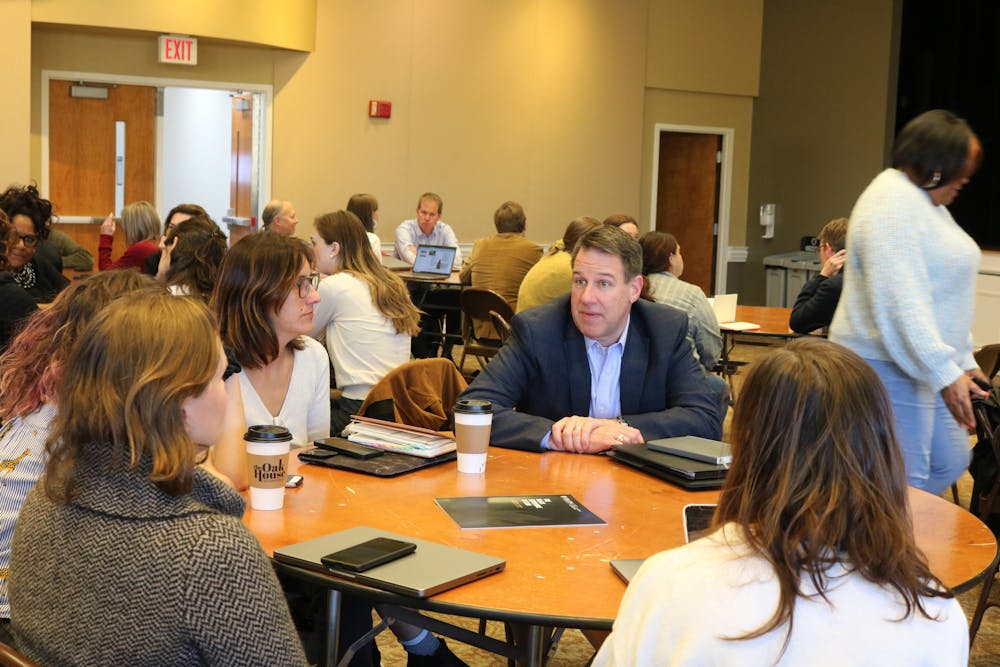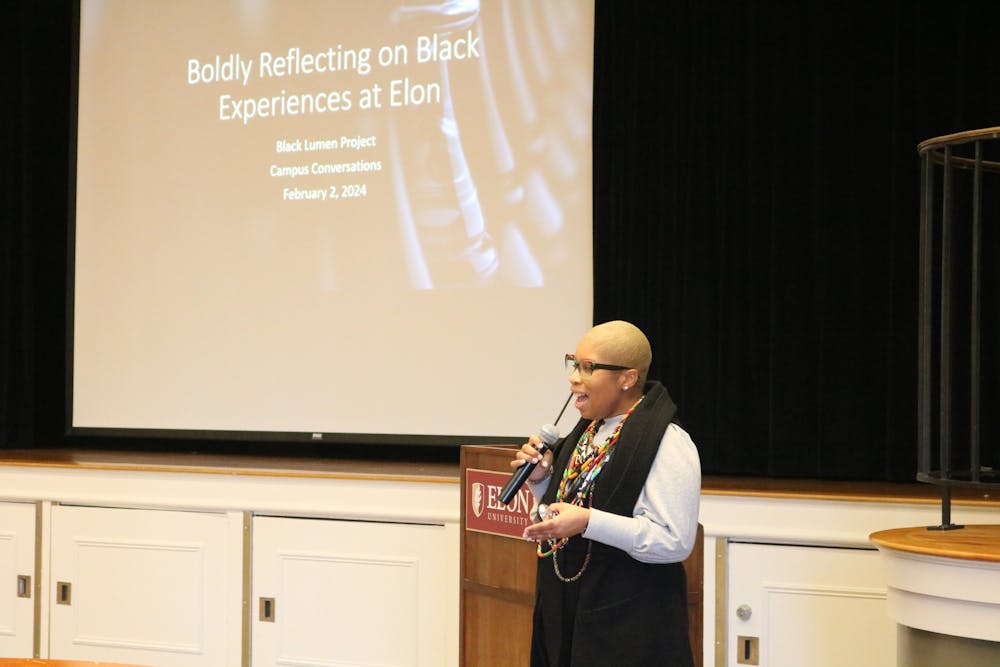One thing that has always amazed professor Amanda Kleintop is how quickly a place can lose its institutional memory.
Kleintop came to Elon in the fall of 2022 — two years after Elon’s History and Memory committee released a report sharing stories from Elon’s history that have been historically overlooked. Since she came to Elon and began teaching with the report, she said few students are aware of Elon’s history and racial injustices that took place.
This report was created with the goal of bringing healing to the university and those who have been excluded from its history. The History and Memory committee included 13 recommendations to the university and while the committee structure itself is evolving, the work of creating a more inclusive space on campus and addressing lost history is still being done.
Kleintop’s classes — particularly her introductory museum studies course — ties in the history from the report throughout the class. This culminates with students creating their own project working through a way to rectify an aspect of Elon’s history.
“We asked, ‘What is Elon’s role here?’” Kleintop said. “‘Is Elon complicit? How should we think about Elon in the larger community too?’ I think it’s in a lot of our broader goals of community engagement.”
Elon sophomore Tori Layton’s final project in Kleintop’s class focused on a proposal to rename Long building on Elon’s campus, after learning about how that building was named after a family who has ties to white supremacy and the lynching of Wyatt Outlaw that occurred in Alamance County in 1870.
Layton said as someone who grew up in the south, she was not surprised to hear about some of Elon’s history. She said she believes there is still work to be done across campus, regarding the history of building names and racial injustices that occurred on campus or within the county.
“Even though it's not a good thing, it's to be expected,” Layton said. “I think that we should do more to recognize it. We had the history and memory report, which was a lot of work, and people don't know about it unless they choose to take that course and engage with the material.”
History and Memory Committee Chair Evan Gatti has been a part of the committee since 2021. Though the committee was on hold for the 2023 year, the research that came from the 2020 report has continued to shape campus. The research has led to classroom discussions, virtual and in-person tours highlighting lesser known aspects of campus, Elon’s Black Lumen Project and more. Gatti said this work has also been shaped by university archivists, specifically the work of Shaunta Alvarez, digital collections and systems librarian.

Senior Jasper Myers works as a student assistant for the university archives, focusing mainly on instances of Black history. Her research has focused on key figures before, during and after Elon participated in racial integration. From there, her research has shaped campus tours, highlighting this history.
Myers said she has participated as a supplemental tour guide on two campus tours so far, one for Kleintop’s museum studies course. She hopes to continue giving tours for other students, especially for students such as members of the African Diaspora Living Learning Community.
Her role as a student leading other students is to facilitate conversations. One of her goals is to create a safe environment for students to learn and grow and considers these tours to function more as “moving class sessions.”
“A lot of it was asking questions like having conversations and bridging dialogue, trying to get people to participate,” Myers said. “I think that it's much easier to get people to care about history when they get to form their own opinion or engage in debates or dialogue and discussions.”
Myers said she is building off the work of university archives, the History and Memory Committee and alumna L’tanya Richmond ’87 who helped establish Elon’s Center for Race, Ethnicity and Diversity Education. Myers hopes her research and products of it become highly accessible to the Elon community.
“Any public institution has a responsibility to be transparent about its history, especially as it relates to disenfranchised and minority communities,” Myers said.
While some aspects of Elon’s racial history have been publicized, such as the first Black full-time student at Elon, Glenda Phillips Hightower, and first Black graduate, Eugene Perry, other aspects of Elon’s history Myers feels have been forgotten.
Myers said one example of this is the unnaming of Colonnades E, despite it happening four years ago in the summer of 2020.It was previously named after former Elon President William Harper. Harper played a role in lynching John Jeffress in 1920, a Black man who was on trial for an alleged rape, but was taken from jail and lynched before his trial. After a petition started by an alumna received over 5,000 signatures, the Colonnades building was renamed.
“A lot of people don't know that history — the history that is less PR friendly,” Myers said. “I'm hoping to encourage some critical discussions about why certain pieces of history are left out of the public facing narrative, and how we can proceed now knowing those things and why is it important to talk about those things?”
More details on Harper are included in the 2020 report released by the History and Memory Committee and other less known stories. Gatti said while the 13 recommendations that came out of the report are in varying levels of completion, a lot of the work being done is an ongoing process. Goals such as “commit to engaging in inclusive, equitable and restorative justice,” is something Gatti said work has been done to rectify, but that the work is never fully completed.
With the unnaming of Colonnades E, Gatti said there has been discussion on how to ensure that history is preserved, without simply putting a plaque of Harper and his support of white supremacy up in the building that residents would see everyday.
“You want to create a commemorative landscape but not a traumatic landscape,” Gatti said. “That's tough.”
A project that came out of the History and Memory Committee is the Black Lumen Project, directed by Professor Buffie Longmire-Avital. Its purpose is to create a more inclusive space and continue advancement for the Black community at Elon.
Last June, the project released the inaugural Black Lumen Report, detailing Black contributions from faculty, staff and students at Elon. Now, Longmire-Avital has been having meetings across campus with different groups including senior staff members, academic affairs directors and Elon’s Black Alumni Network to get feedback on the report. Longmire-Avital said these conversations will determine next steps for the project.
Longmire-Avital also said next steps for the project include having workshops in Alamance County and on campus for Black identifying students, specifically interested in owning a business. This stems from one of the stories from the History and Memory Report on Wyatt Outlaw, a Black man and prominent business figure in Graham who was lynched in 1870.
“He was a dynamic entrepreneur and investor in the very early iterations of kind of the Black Bottom district which is the Black business district of Alamance County,” Longmire-Avital said. “So, when he was murdered, not only was there a loss of life and a loss of a family member and friend, but there was also this significant infrastructural loss to the development of future development of entrepreneurship and small business ownership.”
This is a project Longmire-Avital said will be launching later this year.
Moving forward, Naeemah Clark, associate provost for academic inclusive excellence, is working to further empower organizations across campus that are already doing antiracist work. Clark hopes to increase visibility of this work across the university. The committee will also be reseated by Provost Rebecca Kohn who has final decision on the committee.
“We can't just be one person doing the work,” Clark said. “But thinking through how do we look at the charge and how do we do it in a way that makes sense for where we are today? We don't need to have six people writing, doing history anymore, we need everyone to be engaging.”
Clark said she is focusing on creating a more sustainable structure for the committee and is looking at highlighting different spaces across campus. Clark said the History and Memory Committee has been productive so far, yet due to different members leaving the university, or focusing on other roles, the responsibility of the committee has fallen on a few people.
“History takes a long time to do,” Clark said. “I think with the folks who get on board with the committee, have to just sort of commit to this is going to be a three year process of helping people tell stories.”


